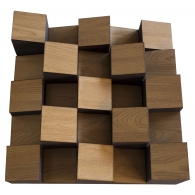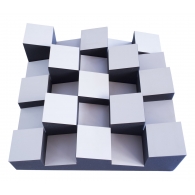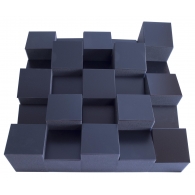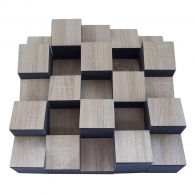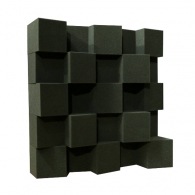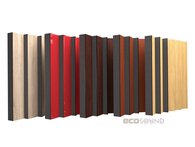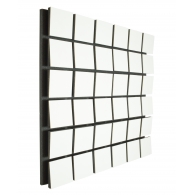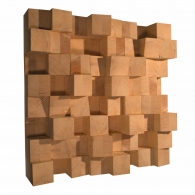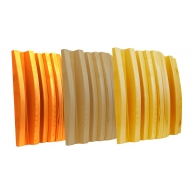Diffusers
-
Diffusers-diffusers Ecodiff foam cream are designed to scatter sound frequencies and waves. This type of panel is in no way equivalent to soundproofing and acoustic panels or slabs. Dimensions 50cm length 50cm width 15cm height. Can be used in acoustic false ceiling systems The presented type of di..DISCOUNT $18.10 -3% $17.56
-
Diffusers-diffusers Ecodiff foam white are designed to scatter sound frequencies and waves. This type of panel is in no way equivalent to soundproofing and acoustic panels or slabs. Dimensions 50cm length 50cm width 15cm height. Can be used in acoustic false ceiling systems This Ecodiff foam white ..DISCOUNT $18.10 -3% $17.56
-
Diffusers-diffusers Ecodiff foam black are designed to scatter sound frequencies and waves. This type of panel is in no way equivalent to soundproofing and acoustic panels or slabs. Dimensions 50cm length 50cm width 15cm height. Can be used in acoustic false ceiling systems The presented type of Ec..DISCOUNT $18.65 -3% $18.09
-
Ecodiff foam diffusers are designed to diffuse sound frequencies and waves. This type of panel is in no way equivalent to soundproofing and acoustic panels or slabs. Dimensions 50cm length 50cm width 15cm height. Can be used in acoustic false ceiling systems The presented type of Ecodiff foam black..$18.10
-
Ecodiff foam diffusers are designed to diffuse sound frequencies and waves. This type of panel is in no way equivalent to soundproofing and acoustic panels or slabs. Dimensions 50cm length 50cm width 15cm height. Can be used in acoustic false ceiling systems This Ecodiff foam diffuser design direct..$19.96
-
Ecodiff foam diffusers are designed to diffuse sound frequencies and waves. This type of panel is in no way equivalent to soundproofing and acoustic panels or slabs. Dimensions 50cm length 50cm width 15cm height. Can be used in acoustic false ceiling systems The presented type of Ecodiff foam black..DISCOUNT $13.13 -3% $12.74
-
Diffuser panels have nothing to do with acoustic panels, whose job is to absorb sound waves. The effect of using PINDIFF CRATER diffusers can be equated to the effect of using an electronic equalizer, which has a Surround function - surround sound. They are designed to break up a sound wave into sm..$20.43
-
Diffuser panels have nothing to do with acoustic panels, whose job is to absorb sound waves. The effect of using diffusers-diffusers Tetras diffuser can be equated to the effect of using an electronic equalizer, which has a Surround function - surround sound. They are designed to break up a sound w..$20.70
-
Purpose: Scattering of sound waves, with further redistribution of their acoustic energy in the space of the music room. Due to its relief, the EcoDiff White acoustic diffuser is able to dissipate the lowest frequencies. Below the diffuse range, the diffuser acts like a normal flat reflective surfa..$19.28
-
Purpose: Scattering of sound waves, with further redistribution of their acoustic energy in the space of the music room. Due to its relief, the EcoDiff White acoustic diffuser is able to dissipate the lowest frequencies. Below the diffuse range, the diffuser acts like a normal flat reflective surfa..$19.11
-
Skyline acoustic diffusers. Skyline acoustic diffusers are one of the most massive and efficient acoustic diffusers. Weighing approximately 15 kilograms, this cone is crafted from pure acoustic spruce, which has unique natural sound-repelling properties. This element of acoustic correction is absol..$240.64
-
EcoWOOD diffusers are designed to diffuse sound frequencies and waves. This type of panel is in no way equivalent to soundproofing and acoustic panels or slabs. Dimensions 60 cm length 60 cm width 135 mm. p.p1 {margin: 0.0px 0.0px 0.0px 0.0px; line-height: 15.0px; font: 13.0px Arial; -webkit-text-s..$240.64
Acoustic diffusers are designed to scatter sound waves in all directions. Due to the diffusers, a uniform sound field is achieved. When a sound wave enters the diffuser, it breaks up into many small reflections, while losing its energy.
How to get the most out of diffusers?
Properly installed diffusers help to achieve the effect of increased room volume.
For best performance, diffusers are best used in conjunction with acoustic foam panels to achieve a combination of diffusion and absorption that will help you achieve optimal sound in your studio, cinema, and more.
Diffusers dissipate frequencies from 300-500 Hz to 4500 Hz.
Professionals recommend working at a distance of more than three meters from the diffuser. At a distance closer than three meters, significant distortion will be heard.
Features of delivery of acoustic diffusers Skyline and Ecowood.
Making diffusers from wood (Skyline and Ecowood models) is a rather long and painstaking work that is done by hand. Therefore, we warn about the pre-order of wooden models for a period of 2-3 weeks.
You can buy acoustic foam models in USA from a warehouse or order delivery.
As music enthusiasts and audiophiles, we are always on the lookout for ways to improve our listening experience. One often overlooked but highly effective tool in achieving optimal sound quality is the diffuser. Diffusers come in many shapes and forms, each serving a unique purpose in sound management and spatial acoustics.
In the United States, diffusers have become increasingly popular in both professional recording studios and home audio setups. Whether you are a musician, producer, sound engineer, or simply a lover of music, incorporating diffusers into your sound environment can significantly enhance the clarity, depth, and overall quality of sound reproduction.
One of the most commonly used diffusers is the acoustic diffuser. Acoustic diffusers are designed to scatter sound waves, thereby reducing echo and reverberation in a room. This helps to create a more balanced sound environment and prevent the buildup of unwanted noise reflections. Different materials can be used to construct acoustic diffusers, such as foam rubber, wood, or spruce. Each material has unique acoustic properties that affect the diffusion pattern and overall sound quality.
Foam rubber acoustic diffusers are affordable and lightweight, making them an ideal choice for home audio setups and small recording studios. Their porous structure effectively scatters sound waves, helping to create a more even distribution of sound energy within a room. Foam rubber diffusers are also easy to install and can be customized to fit different room sizes and shapes.
Wooden acoustic diffusers, on the other hand, are known for their natural and warm sound characteristics. Wood diffusers can be made from a variety of hardwoods, such as oak, mahogany, or cherry, each offering a unique tone and aesthetic appeal. Wooden diffusers are often used in high-end recording studios and concert halls to enhance the acoustics of the space and create a more immersive listening experience.
Spruce acoustic diffusers are a popular choice for those seeking a balance between sound quality and affordability. Spruce wood is known for its lightweight and durable properties, making it an excellent material for constructing diffusers. Spruce diffusers are commonly used in medium-sized studios and live music venues to improve sound dispersion and reduce unwanted reflections.
In conclusion, diffusers play a crucial role in achieving optimal sound quality and spatial acoustics in any sound environment. Whether you are looking to enhance your home audio setup or improve the acoustics of a professional recording studio, diffusers offer a cost-effective and efficient solution. By incorporating acoustic diffusers, wooden diffusers, foam rubber diffusers, or spruce diffusers into your sound environment, you can enjoy a more immersive and balanced listening experience.

